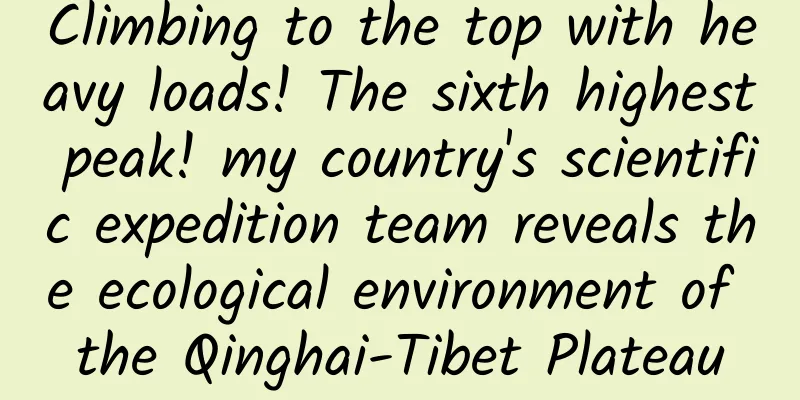Climbing to the top with heavy loads! The sixth highest peak! my country's scientific expedition team reveals the ecological environment of the Qinghai-Tibet Plateau

|
On the morning of October 1, with the joint efforts of 18 scientific expedition members, China's second automatic weather station above 8,000 meters was successfully erected on the peak. So far, the five gradient automatic weather stations planned to be built on Cho Oyu, the sixth highest peak in the world, have all been completed, with altitudes of 4,950 meters, 5,700 meters, 6,450 meters, 7,100 meters and 8,201 meters. This marks a solid step forward in the construction of the Cho Oyu Peak gradient meteorological observation system, which will provide strong data support for revealing climate change at extremely high altitudes and its impact on the ecological environment of the Qinghai-Tibet Plateau. The Cho Oyu expedition is the first time that a Chinese scientific expedition team has climbed a peak over 8,000 meters other than Mount Everest since the founding of the People's Republic of China. It is also the first comprehensive scientific expedition organized after the formal implementation of the Qinghai-Tibet Plateau Ecological Protection Law. Cho Oyu, the sixth highest peak Cho Oyu is located on the border between China and Nepal, in the middle of the Himalayas, with an altitude of 8,201 meters. It is the sixth highest peak in the world and is about 30 kilometers east of the "top of the world", Mount Everest. It is majestic and covered with snow all year round. The westerly-monsoon synergy in the Cho Oyu region is more intense than that in the Everest region, and it is the mountain with the thickest snow and ice on the summit of all peaks above 8,000 meters, preserving the potentially richest archive of climate change at extremely high altitudes. At the same time, the Gabra Glacier here is the best area to study the impact of glacier retreat on the structure and function changes of periglacial ecosystems, as well as their carbon source and carbon sink processes. It is also an ideal area for conducting dynamic surveys of human health at extremely high altitudes. Climb to the top with heavy loads and build a weather station Mount Cho Oyu not only has rugged terrain and harsh climate, but also, unlike the bedrock of Mount Everest, has thick snow cover at extremely high altitudes, requiring scientific expedition team members to increase the weight of the base to ensure the smooth construction of the meteorological station. Therefore, the average weight carried by the expedition team members this time was 40 kilograms, 5 kilograms more than during the Mount Everest expedition; plus, the summit time was relatively later and the temperature was lower, which brought greater challenges to the station construction. On October 1, scientific expedition team members were on their way to the summit. Source: Xinhua News Agency A key part of the scientific expedition is to complete the installation of five gradient automatic weather stations at extremely high altitudes . Zhang Lei, an assistant researcher at the Chinese Academy of Meteorological Sciences and a member of the "Peak Mission 2022-Comprehensive Scientific Investigation and Research on Extremely High Altitude Areas of Mount Everest" expedition team, recalled that last year he participated in the construction of my country's independently developed ultra-low temperature automatic weather station (7028 meters above sea level), during which he needed to climb and transport supplies on steep mountains, and adapt to extreme weather and altitude reactions such as hypoxia. After successfully climbing to the summit of Cho Oyu, the sixth highest peak in the world, the scientific expedition team will not only set up an automatic weather station at extremely high altitudes, but will also carry out a number of scientific expedition tasks such as measuring the thickness of ice and snow on the peak, drilling ice cores, and collecting snow and ice samples. Ice core drilling and snow and ice sample collection On October 1, the second Qinghai-Tibet scientific expedition team of the Cho Oyu Extremely High Altitude Comprehensive Scientific Expedition successfully climbed to the summit of 8,201 meters above sea level and completed ice core drilling and snow and ice sample collection. This is the first time that China has obtained ice cores and gradient snow and ice samples from Cho Oyu . Scientific expedition team members collect snow and ice samples. (Photo provided by the scientific expedition team of Mount Cho Oyu) Ice cores refer to cylindrical ice bodies drilled from glaciers, and are key research materials in the field of glaciology. Ice cores not only preserve information about historical changes in natural climate and environment, but also record the impact of human activities on climate and environment, and play an extremely important role in global climate change research . "All kinds of substances contained in the ice core are the objects of our research. From the top to the bottom of an ice core, the ice layer is formed older as it is formed. Layer by layer, like the growth rings of a tree, records the information of changes in the earth's environment." said Xu Baiqing, a member of the Cho Oyu Extremely High Altitude Comprehensive Scientific Expedition Team and a researcher at the Qinghai-Tibet Plateau Institute of the Chinese Academy of Sciences. Since late September, the expedition team has drilled ice cores and collected snow and ice samples at 6,450 meters, 7,100 meters and 8,200 meters above sea level on Cho Oyu. The collected snow and ice samples will be used to analyze stable isotopes, black carbon, aerosols, etc., and study the environmental changes of Cho Oyu. In addition, the scientific expedition team also obtained snow and ice samples with a gradient interval of 100 meters at an altitude of 6,450 to 8,200 meters for the first time. "Mount Cho Oyu is close to Mount Everest and is strongly affected by the Indian monsoon. By obtaining ice cores from different altitudes, we can trace back environmental changes at different altitudes in different historical periods. Ice cores are like a 'wordless book' that can directly reflect the impact of climate on the glacier melting process under the background of global warming." The ice core and snow ice samples obtained this time are of great significance for the study of extremely high altitude environmental changes and revealing the mechanism of environmental changes on the Qinghai-Tibet Plateau. The second comprehensive scientific survey and research on the Cho Oyu Peak on the Qinghai-Tibet Plateau will focus on major scientific issues such as changes in the Asian water tower, ecosystems and carbon cycles, human activities and living environment safety, mineral resources and geological environment, and reveal the impact of changes in extremely high altitude areas and extreme processes on changes in the ecological environment of the Qinghai-Tibet Plateau. Comprehensive sources: China Meteorological Administration, China News Service, Xinhua Viewpoint, etc. |
<<: The highest team honor award! Chang'e 5's "great achievements" →
>>: Do plants know math? The magical Fibonacci sequence
Recommend
Long-term reasons and short-term investments
Analyzing my own investment experience, I often m...
360 Dianjing bidding promotion system, what is the user experience like?
Since I took over a 360 search promotion project ...
From failure to take-off, how did the Rockets be reborn?
On August 29, 2020, when the United Launch Allian...
How did “GunGun” turn himself into a “living fossil”?
Do you know the answers to these questions about ...
Online event promotion, increased 100,000 users in seven days!
What kind of event can enable a beauty store to g...
9 practical tips for operating mini program + community combination!
In an era when everyone uses WeChat on their mobi...
When turning off the lights and browsing on your phone, is it better to have bright light or dark light?
I wonder if you are like Rong Ge, and like to che...
How to do automobile marketing in the new era?
Telemarketing is difficult nowadays because the s...
Advertising your own products is the correct way to promote your products!
When it comes to promotion , most people think of...
Promotion | Introduction to Fanstong Products
The first in a series of popular science articles...
The State Council's Safety Committee Office reminds you to take precautions →
Year-end and New Year The Ministry of Emergency M...
The Ministry of Industry and Information Technology has issued a list of apps that infringe on user rights, including QQ, 12306, etc.
On December 19, according to the website of the M...
Li Guoqing opposes giving extra points to the children of medical staff fighting the epidemic. Is it reasonable to give extra points to the children of medical staff fighting the epidemic?
Recently, Li Guoqing, the founder of Dangdang.com...
WeChat has launched a "new WeChat" that focuses on social networking for young people
For some of the "older generation" neti...
Tesla shareholders claim $16.8 billion for abuse of power for personal gain, Musk breaks record for compensation for top executives
Elon Musk was sued by Tesla shareholders for alle...









